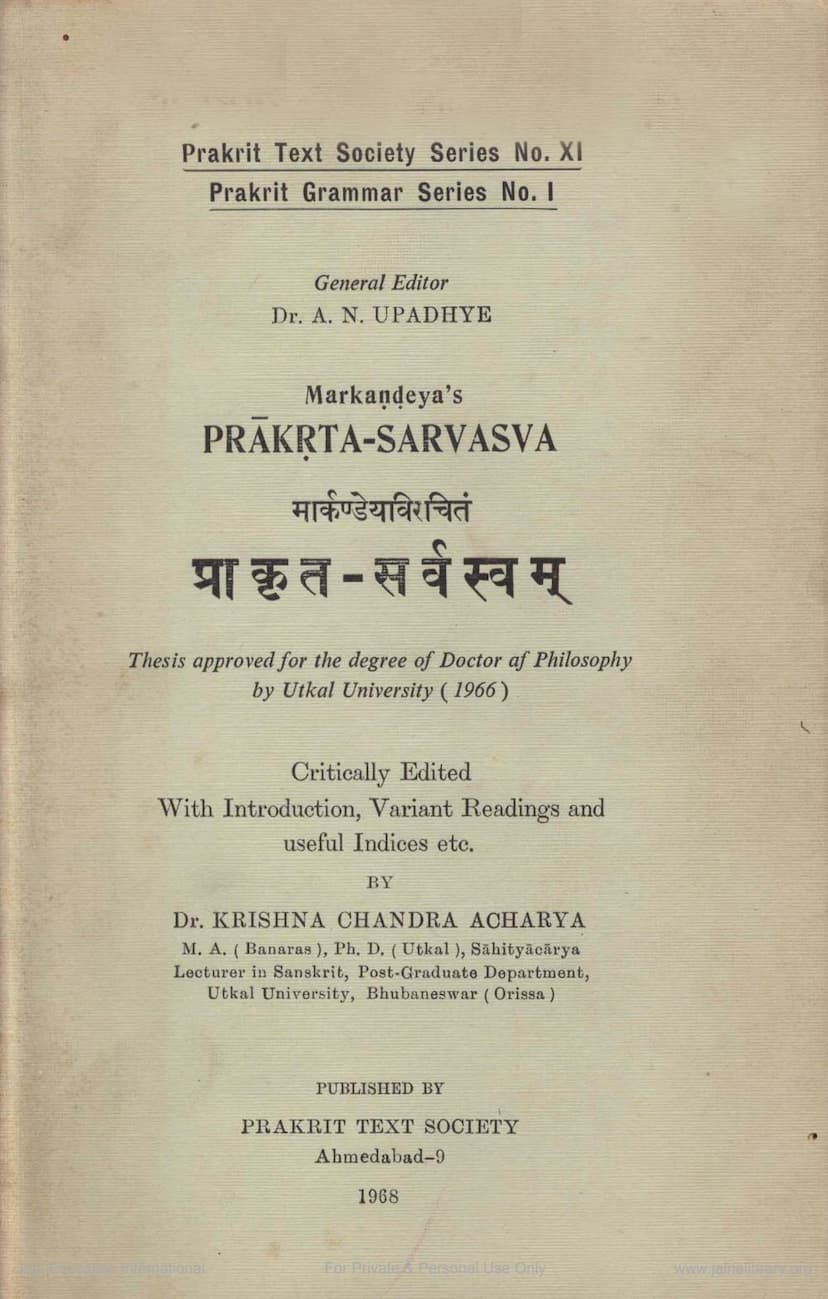Prakritsarvaswam
Added to library: September 2, 2025

Summary
The provided text is the title page, table of contents, preface, introduction, and parts of the critically edited text of Markandeya's Prakṛta-sarvasva (PS), edited by Dr. Krishna Chandra Acharya and published by the Prakrit Text Society, Ahmedabad, in 1968.
Here's a comprehensive summary based on the provided pages:
Book Title: Prakṛta-sarvasva (meaning "Essence of Prakrit" or "All about Prakrit") Author: Markandeya Kavindra Editor/Critical Edition: Dr. Krishna Chandra Acharya Publisher: Prakrit Text Society, Ahmedabad Publication Year: 1968 Series: Prakrit Text Society Series No. XI, Prakrit Grammar Series No. I General Editor: Dr. A. N. Upadhye
Key Aspects of the Text:
-
Significance of the Work: Prakṛta-sarvasva is an important grammar of the Eastern School of Prakrit linguistics. Markandeya flourished in the 16th century, and his work was completed during the reign of Mukundadeva, the ruler of Orissa. The grammar is noted for its thorough treatment of Prakrit and for quoting numerous Prakrit works, many of which are now extant.
-
Critical Edition: This edition is a critical one, based on a thorough collation of various manuscripts, including those previously handled by scholars like Grierson. Dr. Acharya has provided an introduction, variant readings, and useful indices, which were lacking in earlier editions. The preface details the need for a critical edition and the manuscript material used.
-
Author's Biography and Works:
- Date: Dr. Acharya argues that Markandeya flourished in the 16th century, specifically during the reign of Mukundadeva (1559-1568 AD), refuting earlier suggestions of the 17th century.
- Place: Markandeya likely hailed from or resided in Virapratāpapura Śāsana, a village near Puri in Orissa.
- Works: Besides Prakṛta-sarvasva, Markandeya is known to have composed the Vilāsavatī-saṭṭaka (a lost work) and a Mahākāvya called Daśagrivavadha-mahākāvya, which has been published. His title "Kavindra" is justified by his poetic genius, evident even in his grammar's metrical aphorisms.
-
Contents and Structure:
- The grammar is set in metrical form, primarily Arya meter, with occasional Anustubh for convenience.
- It covers various aspects of Prakrit grammar, including the definition of Prākṛta itself.
- Markandeya's classification of Prakrit dialects is detailed, including:
- Bhāṣā: Divided into five kinds (Mahārāṣṭrī, Saurasenī, Prācyā, Avanti, and Māgadhi), with Markandeya rejecting Ārdhamāgadhī, Bāhlīki, and Dākṣiṇātyā as separate categories based on specific linguistic arguments.
- Vibhāṣā: Markandeya recognizes five Vibhāṣās: Śākārī, Cāṇḍālī, Śābarī, Abhirī, and Tākki, excluding Audri and Draviḍi, and excluding the "language of foresters" mentioned in the Natyaśāstra.
- Apabhraṁśa: Three main varieties are recognized: Nāgara, Vraacada, and Upanāgara.
- Paiśācī: Markandeya classifies Paiśācī into three types: Kekaya, Saurasena, and Pāñcāla.
- The grammar draws heavily from earlier authorities like Vararuci, Bharata, and Kohala, and also cites works that are now lost.
-
Linguistic Analysis:
- Prākṛta: Markandeya follows the traditional view that Prākṛta is derived from Sanskrit (Prakṛtiḥ samskṛtam). However, the text also explores alternative etymologies, including Namisādhu's view of Prākṛta as natural, unrefined speech.
- Dialect Classification: Markandeya's analysis of the relationship between Prakrit dialects and their distinguishing features is a significant contribution. His classification and discussions on dialects like Śākārī, Ābhīrī, and Audri are particularly valuable for understanding historical linguistic connections, especially concerning the early stages of Oriya language.
- Influence of Sanskrit: The grammar demonstrates a clear influence of Sanskrit grammar on Prakrit studies, with Markandeya adopting Sanskrit technical terms and grammatical principles.
-
Scholarly Contributions:
- The introduction by Dr. Acharya sheds light on Markandeya's biography, the etymology of "Prākṛta," the classification of Prakrit dialects, forgotten works known to Markandeya, and the source and importance of the PS.
- The editor's work in critically editing the text, including providing variant readings and indices, makes this grammar accessible to modern scholars.
- The publication is recognized as a significant contribution to Prakrit studies, alongside the grammar of Purusottama.
Overall: This publication is a scholarly work that makes a major Prakrit grammar, Prakṛta-sarvasva by Markandeya Kavindra, available in a critically edited form. It provides deep insights into Prakrit linguistics, the historical development of Prakrit dialects, and the literary landscape of ancient and medieval India, particularly in relation to Orissa. The editor's meticulous work in deciphering manuscripts and presenting the complex material has been highly praised.